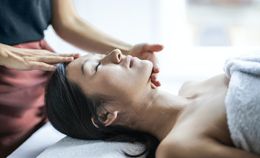Do you live with TMJ? The pain that you experience does not have to be something you endure. There are many different holistic therapies that can be beneficial for managing and bringing relief for TMJ. One such therapy is craniosacral therapy.
Craniosacral Therapy and TMJ
TMJ (Temporomandibular Joint and Muscle Disorders) is a set of chronic disorders affecting the jaw joints and muscles. TMJ can be very painful and, in some cases, even debilitating. Those with TMJ often experience pain and stiffness in their jaw. On occasion, the jaw can even lock up making it hard to open and close the mouth. For sufferers, it often seems like there is no real treatment besides pain medications and expensive, invasive surgery that can cause more problems than it solves.
It can be treated without the need for surgery or severe, uncomfortable disruptions to your life. Craniosacral therapy directly interacts with some of the root causes of TMJ including possible relief from:
-
Muscle tension
-
Facial aches
-
Jaw-locking
Does Craniosacral Therapy work for a TMJ?
Treating TMJ can be a challenge. For most people, TMJ is a chronic annoyance, a bit like a very bad back; disruptive but not necessarily debilitating. It can become very painful, however, and treatment has long been misunderstood. According to National Institute of Dental and Craniofacial Research , doctors have developed surgery to replace jaw joints with artificial implants; but this can cause other problems, as sometimes these procedures cause even more pain and permanent damage. The implants may fail to work correctly or even break apart in the jaw - this is not a risk everyone is often willing to take. And so this is where craniosacral therapy can be helpful.
4 Benefits of Craniosacral Therapy for TMJ
Here is a list of four reasons why craniosacral therapy may be beneficial for TMJ:
-
Natural fit: When it comes to treatment options, craniosacral therapy can be a natural fit for alleviating TMJ symptoms.
-
Noninvasive: No need to worry about an implant breaking, craniosacral therapy is noninvasive. It also works by relying on soft touches that palpate facial muscles and bones to release tensions and stimulate proper function by manipulating the body's circulation of cerebrospinal fluid.
-
Realignment: TMJ is primarily a dysfunction of misalignments and tensions in the jaw making craniosacral therapy an excellent choice of treatment.
-
Gentle: Because craniosacral therapy is gentle, it can be beneficial for TMJ sufferers since pain is often experienced in the areas where craniosacral therapy is performed. Let's take a deeper look at this next.
The Gentleness of Craniosacral Therapy and TMJ
Craniosacral therapy is gentle. This is highly important to TMJ sufferers, especially to those who experience intense pain in the affected area. Gentle touches will not aggravate the condition or pull anything further out of place. Craniosacral therapy for TMJ does not mean that anyone is trying to forcefully yank a jaw into place. It is more of a pinpoint treatment that directly addresses the issues causing pain.
Is Craniosacral therapy for TMJs an Effective Treatment Option?
TMJ is a hard condition to treat, and no one wants to be on painkillers 24/7. Too often it feels like the only relief is somehow to violently and invasively move the jaw back into place.
According to a study published in The Journal of Alternative and Complementary Medicine , many patients report that craniosacral therapy has been very effective for treating TMJ pain.
How effective? Here are findings from the study:
Valued improvement for TMJ: (74%)
Valued improvement for another condition and well-being: (67%)
Decreased need for pain medications: 70%
How Many Sessions are Recommended?
Like TMJ pain, treatment is individualized. You will get to choose the pace of your craniosacral therapy for TMJ. A lot of people will start to notice a difference in pain level and jaw movement after two to three sessions of craniosacral therapy. You may need more or fewer sessions.
Even after getting relief from their TMJ pain, many patients find the experience so relaxing and beneficial to their overall health that they continue to undergo treatment sessions after the TMJ issues have been addressed.
Why? Because through open communication with your craniosacral therapy practitioner and the creation of a treatment plan, you will have a clear idea of how many sessions, and at what frequency, may be needed.
Cost
The average price per session for craniosacral therapy is $70-$170. The overall cost that you will end up spending will depend on the number of sessions you and a practitioner decide is best for your needs. For more information, read: How Much Does Craniosacral Therapy Cost?
References:
Blood, S. (1986). The craniosacral mechanism and the temporomandibular joint. Journal of AOa, 86(8). Retrieved April 11, from https://www.iahe.com/docs/articles/Article_-_The_craniosacral_mechanism_and_the_temporomandibular_joint.pdf
Downey PA, Barbano T, Kapur-Wadhwa R, et al. Craniosacral therapy: the effects of cranial manipulation on intracranial pressure and cranial bone movement. J Orthop Sports Phys Ther. 2006 Nov;36(11):845-53. Retrieved April 11, 2019, from https://www.ncbi.nlm.nih.gov/pubmed/17154138
Harrison, R, & Page, j. (2011). Multipractitioner Upledger craniosacral therapy: descriptive outcome study 2007-2008. The Journal of Alternative and Complementary Medicine (17) 1. Retrieved April 11, 2019, from https://www.iahe.com/docs/articles/Multipractitioner_Upledger_CST_Outcome_Study_-_Full_Article.pdf
Johansson A.,Unell L., Carlsson G., & Soderfeldt B. (2008).Gender difference in symptoms related to temporomandibular disorders in a population of 50-year-old subjects. Acta odontologica Scandinavica. Retrieved April 11, 2019, from https://www.ncbi.nlm.nih.gov/pubmed/18320419
National Institute of Dental and Craniofacial Research. (2018). Prevalence of TMJD and its signs and symptoms. National Institute of Health. Retrieved April 11, 2019, from https://www.nidcr.nih.gov/research/data-statistics/facial-pain/prevalence
National Institute of Dental and Craniofacial Research. (2018). TMJ (temporomandibular joint and muscle disorders). National Institute of Health. Retrieved April 11, 2019, from https://www.nidcr.nih.gov/health-info/tmj/more-info#treatment















